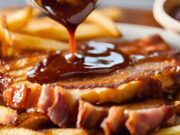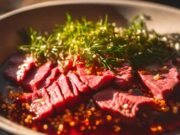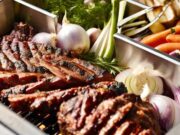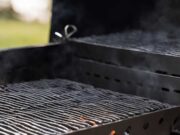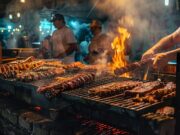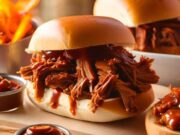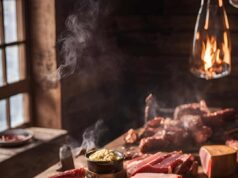When it comes to BBQ, the cut of beef you select can significantly impact the quality of your meal, distinguishing between a good experience and an exceptional one. With numerous options available, understanding which cuts are best for grilling or smoking can elevate your backyard cookout to a new level.
This article examines the top beef cuts that are ideal for BBQ, ranging from the rich marbling of ribeye to the tender texture of brisket. It also outlines essential preparation techniques and seasoning tips to ensure your BBQ is a resounding success.
Prepare to impress your guests with delicious, mouthwatering beef!
Key Takeaways:
- When choosing beef cuts for BBQ, look for cuts with plenty of marbling and fat content for optimal flavor and tenderness.
- The top cuts for BBQ are ribeye, sirloin, brisket, porterhouse, and chuck roast. Each has its own unique flavor profile and cooking method.
- Marinating and seasoning are key preparation techniques for a successful BBQ. Experiment with different flavors and methods to find your perfect BBQ flavor combination.
Beef Cuts for BBQ: What You Need to Know
Regarding barbecue, understanding the various beef cuts is essential for achieving that perfect smoky flavor and tenderness. Quality beef cuts, such as those from Nebraska Star Beef, provide a variety of options, from the juicy Tri-Tip to the flavorful Chuck Roast, each bringing its unique characteristics that enhance your culinary experience.
Knowing how to select, season, and prepare cuts like Short Ribs and Brisket will elevate your barbecue skills, ensuring a meal that is both tender and rich in flavor. This guide will help you break down the best beef cuts for BBQ and show you how to optimize their taste and texture.
Understanding Beef Cuts
Understanding beef cuts is essential for any barbecue enthusiast, as the specific cut of meat can significantly influence both the flavor and tenderness of your dish.
Each beef cut, whether it is a succulent ribeye or a lean sirloin, contains varying levels of marbling and connective tissue, which affects the appropriate cooking and seasoning methods.
For example, cuts such as the Top Sirloin and filet mignon are well-known for their tenderness, while others like the Chuck Roast may necessitate longer cooking times to break down collagen and achieve a juicy, tender texture.
What Makes a Cut Ideal for BBQ?
An ideal cut for barbecue combines excellent marbling with the right balance of tenderness and flavor, ensuring a delicious outcome when cooked. Cuts with higher fat content tend to be more flavorful and juicy, particularly when grilled or smoked at low temperatures to reach the perfect internal temperature.
For instance, the ribeye is renowned for its rich flavor and marbling, while the tenderloin is known for its tenderness, making it a favorite among barbecue enthusiasts seeking a savory experience.
When selecting a cut for barbecue, you should also consider the flavor profile that aligns with your personal preferences and the cooking technique. For example, brisket, with its robust flavor and significant fat cap, becomes melt-in-your-mouth tender when cooked slowly, allowing the connective tissues to break down effectively.
Chuck eye steak, often overlooked, offers a combination of affordability and great taste, along with commendable marbling, making it an excellent choice for grilling.
To best showcase these exceptional qualities, employing methods like indirect grilling or low-and-slow smoking can enhance both flavor and tenderness, achieving mouthwatering results that will have your guests coming back for more.
Top Cuts for BBQ
When selecting the top cuts for BBQ, you will find that options such as Ribeye, Sirloin, Brisket, Porterhouse, and Chuck Roast stand out for their unique flavors and cooking qualities.
The Ribeye, renowned for its exceptional marbling, is a popular choice for grilling due to its juicy and tender characteristics. In contrast, the Sirloin offers a leaner alternative without compromising on flavor.
For those who appreciate slow-cooked, smoked meats, Brisket is an essential option. The Porterhouse provides a remarkable combination of tenderness and robust flavor, making it an excellent choice for BBQ enthusiasts.
Lastly, the Chuck Roast, rich in connective tissue, can be transformed into a sumptuous dish when cooked low and slow.
1. Ribeye
The Ribeye steak is often regarded as the king of barbecue cuts, thanks to its exceptional marbling that guarantees juicy and flavorful bites. This cut, sourced from the rib section of the cow, is rich in fat, making it ideal for high-heat cooking methods like grilling, which enhance its natural flavors. Its tenderness is particularly appealing to meat enthusiasts, who value its melt-in-your-mouth quality and robust taste, especially when seasoned with a dry rub or smoked over hickory wood.
To truly elevate your Ribeye experience, grilling over direct heat is an effective technique, allowing the fat to render beautifully while developing a delicious crust. Alternatively, smoking the steak at a lower temperature introduces a depth of flavor that grilling alone cannot achieve.
Regarding seasoning, simple blends of salt, pepper, and garlic powder can work wonders, while marinating with herbs like rosemary or thyme can provide a refreshing twist. For optimal tenderness and juiciness, it is crucial to monitor the internal temperature; aim for 130°F for medium-rare, where the robust flavor truly shines, ensuring that each bite remains succulent and delicious.
2. Sirloin
Sirloin, recognized for its lean yet flavorful profile, is an excellent choice for those seeking a healthier barbecue option without compromising on taste. This cut is highly versatile; it can be grilled, roasted, or utilized in kabobs, making it a popular selection for family gatherings and backyard barbecues. The combination of affordability, variety, and rich flavor makes Sirloin a staple in many BBQ recipes, whether you are preparing a classic steak dinner or incorporating it into a meatloaf mix.
Among the various types of Sirloin, Top Sirloin is often preferred for its tenderness and robust flavor, making it ideal for grilling to medium-rare perfection. Conversely, the Bottom Sirloin, while slightly tougher, offers a unique depth that truly shines when marinated.
Seasoning is essential for enhancing the natural flavors of these cuts. Simple rubs of salt and pepper or a marinade featuring garlic and soy sauce can significantly elevate their profiles.
Whether your focus is on a hearty steak or savory kabobs, Sirloin proves to be an adaptable choice that seamlessly fits various cooking methods and seasoning styles, ensuring a delicious meal every time.
3. Brisket
Brisket is a quintessential BBQ cut, recognized for its rich flavor and remarkable tenderness when cooked low and slow, making it a favorite among pitmasters. This cut, sourced from the chest of the cow, is typically smoked for several hours, allowing the collagen to break down and infuse the meat with a delightful smoky aroma and taste. A well-prepared brisket can serve as the centerpiece of any barbecue, often accompanied by a zesty BBQ sauce or featured in sandwiches, showcasing its versatility and depth of flavor.
To achieve that desired tenderness and flavor, you can employ various cooking techniques, including smoking, braising, and sous-vide. Each method requires careful temperature control; for instance, smoking at approximately 225°F yields optimal results, ensuring the brisket cooks evenly while developing a delicious bark. Equally important are the resting periods after cooking; allowing the brisket to rest redistributes the juices, enhancing the succulence of each bite.
Seasoning is also critical; simple rubs of salt and pepper can highlight the meat’s natural flavor, while marinades that incorporate garlic, herbs, and even a splash of vinegar can elevate the taste profile and enhance moisture.
4. Porterhouse
The Porterhouse steak is a sought-after cut, recognized for its impressive size and the exceptional combination of flavor and tenderness it provides. This cut includes both tenderloin and strip steak, making it a favorite among grilling enthusiasts who appreciate a hearty meal. Its thickness makes the Porterhouse ideal for high-heat cooking, allowing for a beautiful sear while preserving its juiciness and tenderness. When prepared correctly, this cut can satisfy even the most discerning steak lovers.
To achieve optimal results, it is essential to control the cooking temperature and properly season the meat. Begin by allowing the steak to reach room temperature before grilling, which promotes even cooking. A straightforward seasoning of kosher salt and freshly cracked black pepper will enhance the natural flavors, but you may also experiment with garlic powder or fresh herbs for added depth.
For perfect grill marks, place the steak on a preheated grill and resist the temptation to move it too soon. Aim for an internal temperature of 130-135°F for medium-rare, ensuring that the Porterhouse remains juicy and flavorful, ready to impress at any barbecue.
5. Chuck Roast
Chuck Roast is an excellent choice for those who appreciate the depths of flavor that emerge from slow cooking. Its marbling contributes to a rich taste and tenderness when prepared correctly. Frequently utilized in pot roasts, this cut can also be transformed into succulent barbecued meat by cooking it at low temperatures for several hours, allowing the connective tissue to break down into flavorful morsels. The versatility of Chuck Roast makes it a superb option for both family dinners and BBQ gatherings.
To achieve optimal results, employing the low and slow cooking method is essential, as it ensures the meat becomes tender and succulent, making it ideal for braising or slow roasting. Incorporating a marinade or dry rub will enhance the intrinsic flavors of the Chuck Roast, resulting in a culinary delight. Seasoning with herbs and spices not only elevates the flavor profile but also complements the natural richness of the meat, creating a mouthwatering dish that is sure to satisfy appetites and impress guests.
Whether you are simmering it in a hearty stew or grilling it to barbecue perfection, the right approach will ensure that this cut truly shines in any meal.
Preparation Techniques
Effective preparation techniques are essential for maximizing the flavor and tenderness of your beef cuts for BBQ, with marinating and seasoning being two of the most popular methods.
Marinating involves soaking the meat in a mixture of liquid and spices, which allows for deep flavor penetration. On the other hand, dry rubs provide a concentrated burst of seasoning that enhances the natural taste of the cut.
Whether you choose a sweet or zesty BBQ sauce, understanding these techniques can significantly elevate your culinary experience and ensure your beef is juicy and tender.
Marinating and Seasoning Tips
Marinating and seasoning tips are crucial for infusing flavor into your beef cuts and ensuring they are tender and juicy when it’s time to barbecue. A good marinade typically includes acidic components such as vinegar or citrus juice, along with spices and herbs, which work to break down the meat’s fibers, enhancing its tenderness while imparting rich flavors. Similarly, a well-balanced dry rub can create a savory crust on the beef, sealing in moisture and flavor for a delicious result.
To create an effective marinade, consider combining oil, acid, and a variety of herbs and spices. For instance, a classic Cuban marinade features lime juice, garlic, and oregano, while a spicier option may include soy sauce, ginger, and chili paste. It is important to allow the beef to soak in the marinade for at least a few hours, or even overnight, to achieve maximum effect.
For dry rubs, a mixture of salt, pepper, and complementary spices such as paprika or cumin can enhance the flavor profile of various cuts, from tenderloin to brisket. A coffee-based rub, for example, can impart a deep, rich flavor to a thick cut, while a simple blend of brown sugar and mustard powder works wonders on ribs.
Choosing the Right Cut for Your BBQ
Choosing the right cut for your BBQ ultimately depends on your personal preference and the specific flavor profile you aim to achieve. You may prefer the rich, fatty attributes of a Ribeye for a juicy steak experience, while others might opt for the leaner Sirloin for a healthier meal option.
Understanding the characteristics of each cut, including tenderness and marbling, will aid you in selecting the ideal beef cut that meets your culinary desires and satisfies your guests.
It is essential to consider not only your tastes but also what will resonate with those you are serving. For instance, when hosting a gathering, you may want to offer a variety of cuts to cater to diverse preferences—perhaps pairing a tender Filet Mignon with a bold, smoky marinade while reserving a brisket for slow cooking to draw out its complex flavors.
Matching cooking methods to cuts can significantly elevate your BBQ experience; grilling thicker steaks directly over high heat delivers that desirable char, while tougher cuts benefit from low and slow cooking to break down the collagen for melt-in-your-mouth results.
Ultimately, investing in quality beef will enhance all these flavors, ensuring your barbecue is a memorable occasion.
Frequently Asked Questions
What are the best beef cuts for BBQ?
Some of the best beef cuts for BBQ include brisket, ribs, tri-tip, and short ribs. These cuts are typically well-marbled and can handle the slow cooking process of BBQ, resulting in tender and flavorful meat.
What is the difference between a beef brisket and a beef rib?
Beef brisket is a cut of meat from the chest of the cow, while beef ribs come from the rib section. Brisket is a larger and tougher cut, while beef ribs are smaller and more tender.
What is the ideal temperature for cooking beef cuts for BBQ?
The ideal temperature for cooking beef cuts for BBQ is between 225-250 degrees Fahrenheit. This low and slow cooking method allows the meat to become tender and absorb smoky flavors.
How do I know when beef cuts are done cooking for BBQ?
An instant-read meat thermometer should be used to determine the doneness of beef cuts for BBQ. The internal temperature of cooked beef should be 145 degrees Fahrenheit for medium-rare, 160 degrees for medium, and 170 degrees for well-done.
Can I use any type of beef cut for BBQ?
While some cuts may work better for BBQ than others, you can technically use any type of beef cut for BBQ. Just keep in mind that some cuts may require longer cooking times and may not result in the same tenderness and flavor as recommended cuts.
Are beef cuts for BBQ safe to eat rare?
Beef cuts for BBQ should not be eaten rare, as the slow cooking process is necessary to break down tough connective tissues and make the meat tender. It is important to cook beef cuts for BBQ to at least medium-rare, or an internal temperature of 145 degrees Fahrenheit, to ensure they are safe to eat.








